The Future is Complex

By Jay Friess
Editor
Last November, Britain’s Tomahawk missile team, working in conjunction with the U.S. Navy, was testing their weapon in China Lake, Calif. The team, headquartered in the UK, remotely fired the missile, and it went streaming toward its designated target.
And then something futuristic happened, according to Rear Adm. William Shannon, program executive officer for Unmanned Aviation and Strike Weapons, who told the story at a panel discussion hosted at the Patuxent River Naval Air Museum Wednesday night by The Patuxent Partnership and Association of Naval Aviation Patuxent River Squadron.
A British special forces team on location at China Lake contacted the UK headquarters and requested a new target. Using a satellite link, the Tomahawk team reprogrammed the missile mid-fight, and it changed course to hit a new target.
In the civilian world, where Internet devices regularly communicate instructions over a stable, hardwired networks based on standardized communication protocols, this may not seem like a miraculous thing. For it to happen on a global military satellite network, connected by a tenuous, narrow bandwidth of radio waves, was pretty impressive.
“A lot of our leadership don’t appreciate how difficult it is to connect the dots,” Shannon said. “There are all these nodes that can present a challenge.”
Capt. Bob Dishman, leader of the Naval Air Systems Command’s Integration and Interoperability program, agreed, saying, “Our warfighting is getting much more complicated.”
Nowhere is this more evident than in the Navy’s efforts to mix unmanned systems into its arsenal.
“We’ve got a lot of work to do to integrate unmanned systems into our concept of operations,” said Capt. James Glass, manager of the Navy’s MH-60R Seahawk helicopter program.
Glass’ program spent some time in November experimenting with getting the Fire Scout unmanned helicopter to communicate with operators in a Seahawk. The Seahawk was able to use the Fire Scout to paint objects with a targeting laser and collect and relay live video. But getting that video back to field commanders isn’t easy at the moment. Shannon said that the Fire Scout’s current video feed system relays video back its base ship where it then has to be relayed to a command center via a narrow-bandwidth radio connection.
“This is a great platform to put sensors on,” said Cmdr. Manny Picon, who represented the Fire Scout program. “The challenge is getting the sensor data.”
An audience member asked if the Navy is working on technology that would allow unmanned systems to do more on-board processing, allowing them to relay smaller, more relevant amounts of data. Shannon said he has seen some work in that direction, but added, “There’s nothing that’s transitioning to a program of record.”
























